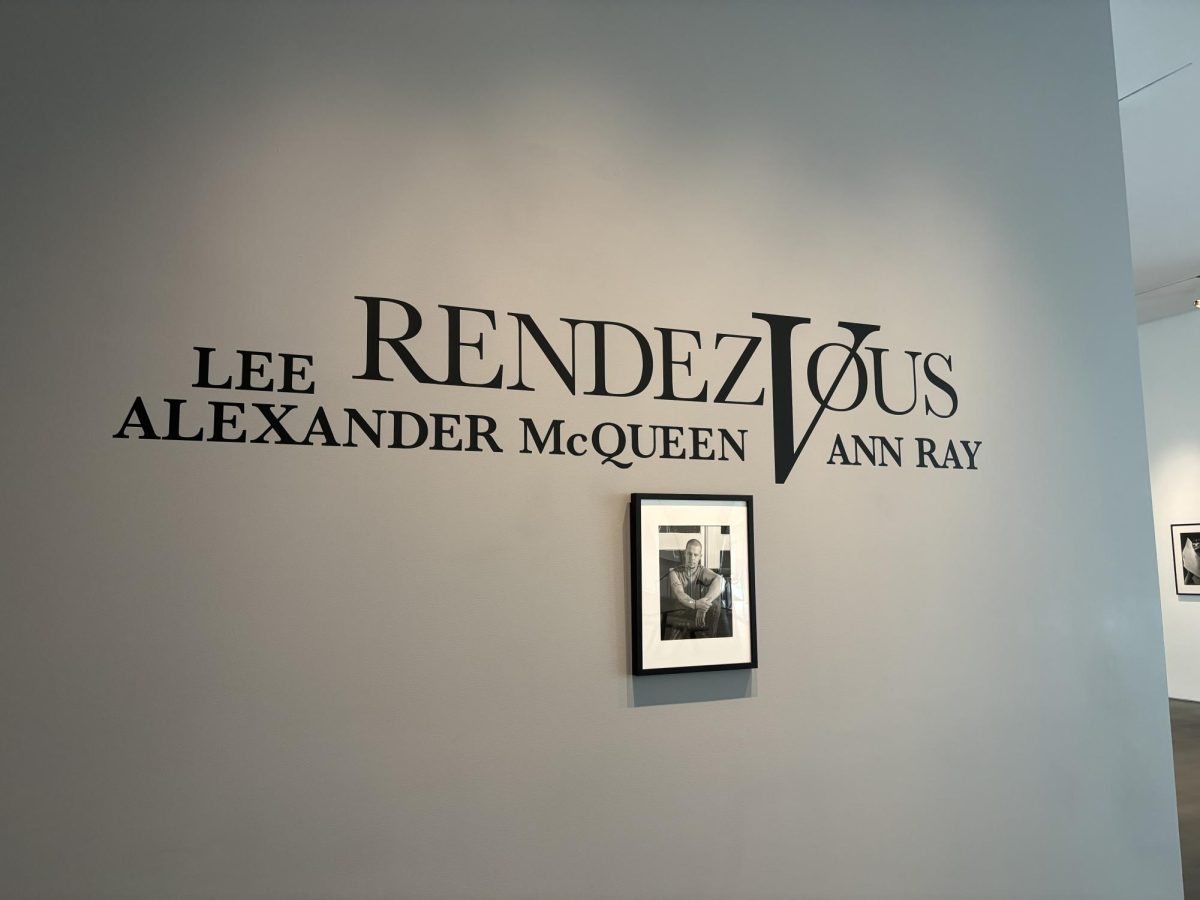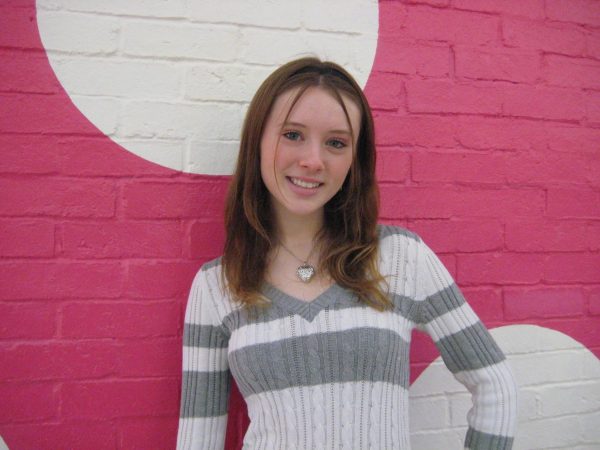“I like your images but I’m broke. Give me your photos, I’ll give you clothes.”
In 1997, fashion designer Lee Alexander McQueen, better known as just Alexander McQueen, befriended photographer Ann Ray. More than just friendship, however, an artistic partnership was born between the two.
Lacking sufficient funds, the two employed a barter system: Ray would photograph McQueen’s work, and McQueen would pay Ray in clothing.
Over the course of 13 years, Ray captured 43 of McQueen’s collections and compiled over 32,000 negatives. Accordingly, Ray is rightfully considered McQueen’s only true photographer.
Over the course of their alliance, Ray came to possess a significant amount of McQueen’s pieces. Yet—due to incongruity between McQueen’s designs and Ray’s personal style—most of these gifts never saw the light of day.
Now, 15 years after his passing, Lee Alexander McQueen & Ann Ray: Rendez-Vous explores the pair’s friendship. Traveling to museums across the nation, the exhibit showcases both McQueen’s garments and Ray’s photographs.
While the sizable collection includes clothes gifted specifically from McQueen to Ray, it goes further, including various miscellaneous pieces from throughout McQueen’s career.
The exhibit serves as a remembrance for the designer, highlighting some of the key points of his work. And—for those of us who weren’t around for the peak of his career—flat out introduces the designer.
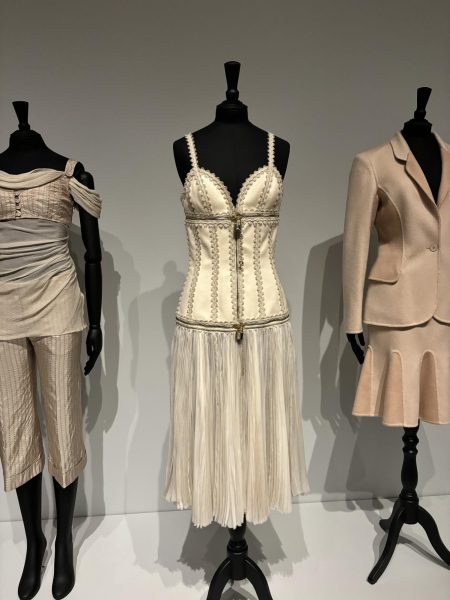
Upon entrance into the exhibit, four near-beige outfits are presented. While all unique in their own way, the most notable is the white silk pleated dress with zippers and gold locks. The garment’s top includes both horizontal and vertical zippers, with a lock and key on each. With its minimalistic shape and drab color scheme, the dress appears like a sort-of 19th century undergarment.
McQueen gifted the dress to Ray in an (unsuccessful) effort to push her outside of her stylistic comfort zone. While initially not a big fan, Ray claims that she could picture herself wearing it now.
Next, the display showcases some of the signature moody looks McQueen is best known for. Spaced out in near darkness, the museum environment only adds to the garments’ gloominess.
First on the row is the black silk and lace dress, taken from Supercalifragilisticexpialidocious, A/W (Autumn/Winter) 2002. An example of one of McQueen’s many works inspired by movies, the collection took influence from director Tim Burton’s films. Made with a combination of leather and lace, the garment easily looks like something Lydia Deetz would have worn in Burton’s 1988 Beetlejuice.
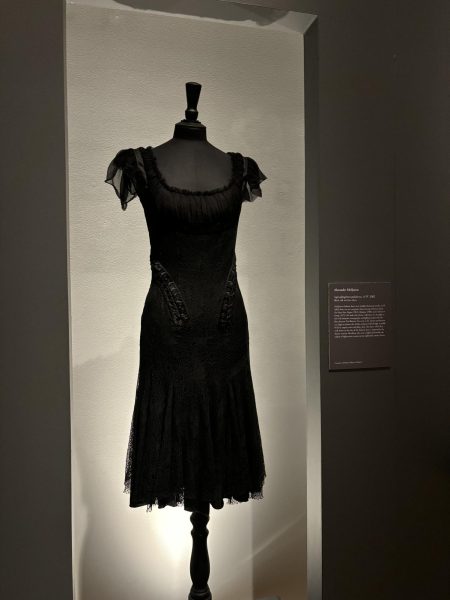
Near the silk dress, the brown leather patchwork coat with fur collar is displayed, taken from Eshu, A/W 2000.
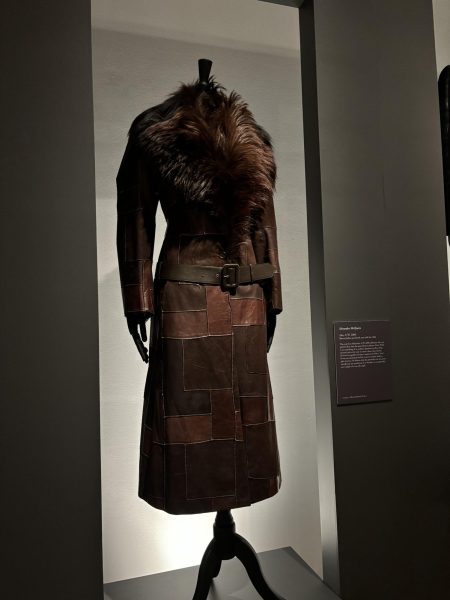
The jacket was a gift to Ray and, understandably, made her feel like a star—the piece seems like it would be worn by a member of the fictional rock band, Daisy Jones & the Six. On a much less extravagant level, the garment serves as a precursor to the recently popular trend of patchwork denim.
From The Overlook, A/W 1999—inspired by the horror film, The Shining—McQueen’s black faux leather and shearling jacket is presented. Understandably, the garment is virtually all dark. It looks like what I imagine 1920s pilots wore and, being more simplistic, was one of Ray’s favorites.
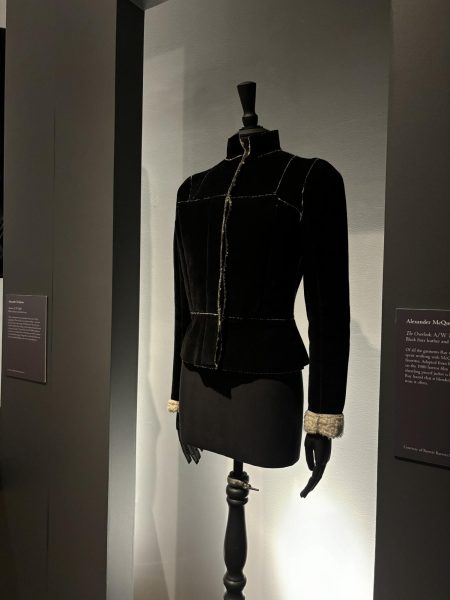
After exiting the area displaying Ray’s personal collection, the exhibit includes a variety of garments from across McQueen’s career.

Another moody look, the black lace short asymmetrical top appears like a Lydia Deetz outfit. Unfortunately, this look never debuted on the runway. Instead, it serves as an example of the designer’s love for last-minute craftsmanship. Famously, McQueen saved at least one look per show to complete moments before his models walked.
With his glass bead and horsehair midi dress, McQueen drew inspiration from African culture, an element reflected throughout the entire Eshu, A/W 2000 collection. Notably featuring Ndebele neck rings and Samburu beadwork, the collection is named after the Yoruba deity who personifies mischief.
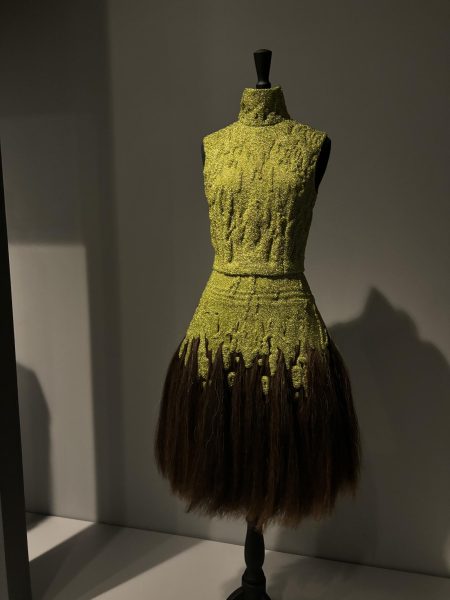
As the exhibit progresses chronologically, more of McQueen’s colorful pieces are revealed. Particularly, his floral and paisley print babydoll dress that strayed far from his dismal design tendencies.
Originally, the cheery garment was in It’s Only a Game, S/S (Spring/Summer) 2005, in which McQueen revisited many of his previously iconic designs. The artistic show was set up as a life-size game of chess—a metaphor for the fashion industry. Dramatically, the final scenes of the presentation included a face-off between models, comparable to a scene from the Harry Potter franchise.
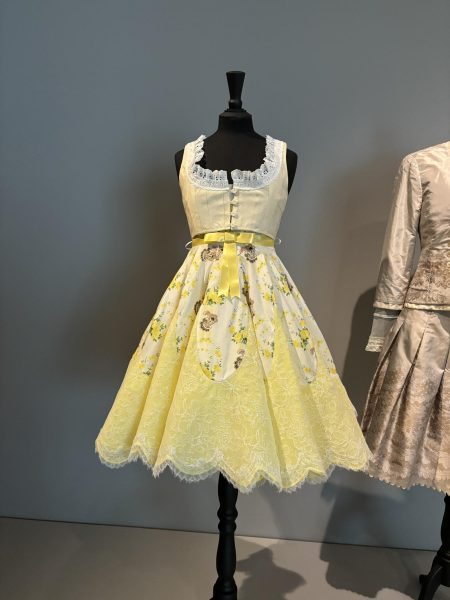
Clearly, the dress itself is incongruous with many of McQueen’s earlier pieces. With a strong sense of femininity, it looks like a crossover between something a little girl would wear on Easter Sunday and the attire of a 1950s housewife. Similarly, it could easily be compared to Belle’s iconic dress from Beauty and the Beast.
While the focal point of the exhibit was the physical garments, Ray’s photographs aren’t to be overlooked. Displayed periodically, they convey key moments in McQueen’s career that the collection would otherwise lack.
A prime example of this is the images from McQueen’s No. 13, S/S 1999 that are showcased. Notably, the show’s finale is represented—one of the most notable moments in recent fashion history.
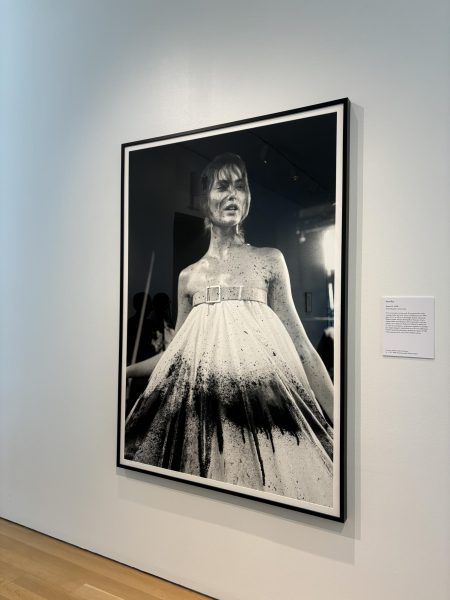
As the story goes, the designer provided next to no instruction to model Shalom Harlow. Instead, he sent Harlow onto the runway with hopes of producing a spontaneous experience. This objective was achieved, as the audience watched as the model’s plain white dress was spray painted. As she stood on a rotating platform, robot arms splattered the dress with yellow and black. With such an artistic concept, the scene played out like a dance, rather than merely a garment’s display.
Particularly in a large up-close image of the model, Ray’s exquisite photography of the incomparable moment is showcased.
While not quite as massive, others of McQueen’s photographs from No. 13 are displayed, including an image of his elm wood prosthetic legs. Made for Paralympic athlete Aimee Mullins, the legs appear more like unique handcrafted boots than fake limbs.
In her images, the photographer captured moments most integral to McQueen’s career. Because of this, audiences are now able to experience these moments that otherwise would have been lost to history.
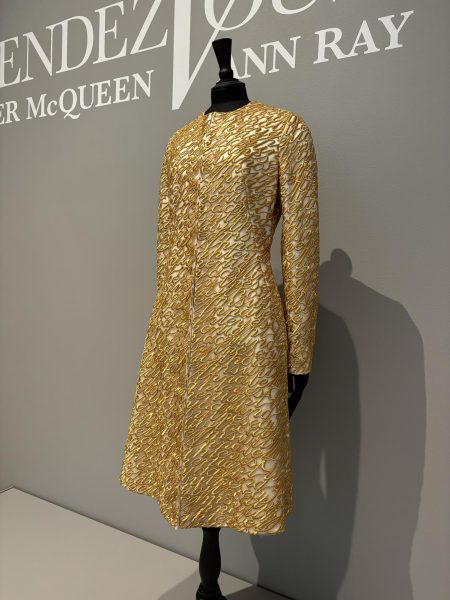
Continuing on with the garments, McQueen created a personalized evening coat for model and friend Annabelle Neilson. While it’s difficult to see without close inspection, the piece is embroidered with the poem “Annabel Lee” by Edgar Allan Poe. While the concept of this piece is captivating, the actual execution of the piece could have—in my non-fashion designer opinion—been improved.
Regardless, Neilson held the gesture close to her heart. Having been given a bolt of the fabric McQueen used to construct the garment, the model considered the gift to be one of her prized possessions. In fact, in a sorrowful turn of events, Neilson ended up reading the poem at McQueen’s funeral.
As his career progressed, McQueen’s designs seemed to become more daring. Correspondingly, Plato’s Atlantis, S/S 2010 exemplified McQueen’s increased experimentation. While before the age of the notoriously vibrant, screen-printed sweatshirts, the dresses seem like a much more luxurious precursor to the fast fashion abominations.
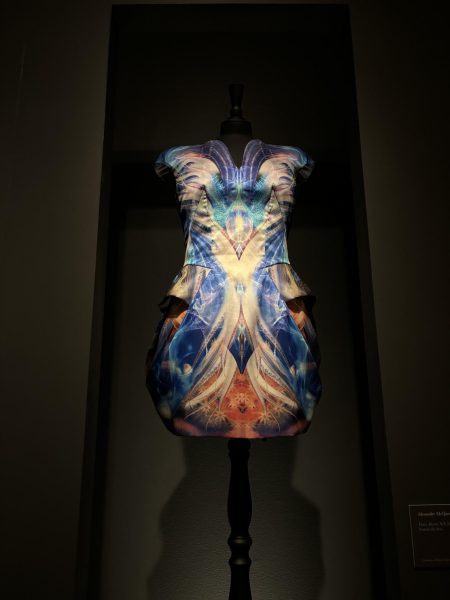
Much different from those sweatshirts, the dresses have meanings that are unclear on the surface. Instead of been drawn from movies like many of McQueen’s other works, the collection is based on Plato’s famous tale of the city of Atlantis.
In the story, the powerful and advanced civilization is destroyed in a war with Athens. McQueen, however, interpreted the tale as a warning of the destruction that climate change would bring on present-day society.
In the runway debut, the models strutted down the catwalk in McQueen’s notable armadillo heels (shoes that essentially make the wearers’ feet look like large lobster claws, famously worn by Lady Gaga in her “Bad Romance” music video) and facial prosthetics. Effectively, the models were converted to animal-human hybrids. According to McQueen, these creatures had adapted to live underwater—a necessity due to rising sea levels.
The collection, understandably, is considered his most important.
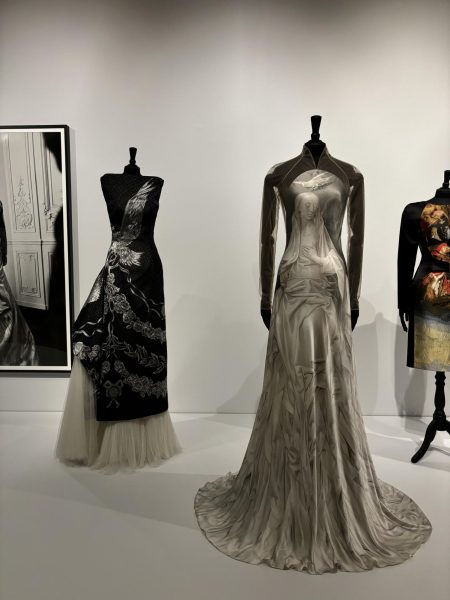
Ironically, the exhibit ends with my personal favorite garments from the collection. With the runway show taking place posthumously, Angels & Demons, A/W 2010 served as a memorial for the recently deceased designer.
The collection is packed with references to Christianity, as seen in the silk “Virgin Mary” evening gown. On this ethereal piece, a monochrome Virgin Mary is printed, taken from a 15th century painting by Hugo van der Goes. Similar to his Plato’s Atlantis collection, many of the garments were screen printed.
If not already clear, McQueen made his fashion shows more than just a display of beautiful garments. In addition to exhibiting the works of art, the shows served as vehicles for both storytelling and societal messaging.
Whether inspired by movies or a calling to share his commentary on the world around him, McQueen bridged a gap between garments and theatrics. His works of art continue to enchant audiences today, something that would be impossible without the help of his trusty photographer and friend, Ray.



























































































